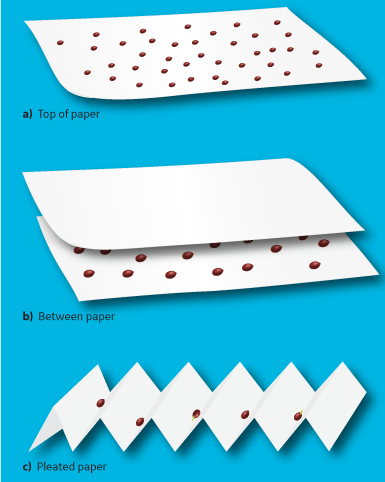When choosing seed testing paper, some properties come to mind first—format, pH, and absence of spores—but what about water retention? Does it have a hidden impact on seed germination tests?
If you work in commercial seed production, quality control tests are likely seen as an essential component of the workflow. As these results influence the value of seeds, any way to maximize seed testing consistency and germination rate is highly desirable.
Let’s take a look at what these tests are, and how water retention—a factor that’s easily overlooked—might affect test results.
What is seed germination testing?
Seed germination tests involve incubating seeds for a set period of time and measuring the rate and quality of germination. These tests are usually conducted in or on a matrix that’s suited to the seeds and testing parameters.
For example, specialized seed testing filter paper is a common matrix for seed germination methods because of its consistency in terms of pH, conductivity, absence of spores, and water retention.
The International Seed Testing Association (ISTA), which was established in 1924, has developed detailed best practice methods, designed to help achieve high and consistent standards of testing. Germination has been a part of these standards since the first publication in 1931, and is a key factor in seed quality and trade value.
The hidden impact of water retention
While ISTA standards contain strict criteria for the conductivity (<40 mS/m), pH (6.0 to 7.5), and toxicity of filter papers, the criteria for water retention is less specific.
Chapter 5.2.4 of the ISTA rules (2011 update) states:
“The water content of the growing medium should be adjusted to correspond to the needs of the species being tested, based on the maximum water-holding capacity of the media.”
Unlike the other criteria, this leaves water content open to some interpretation. Water retention can impact seed tests and that selecting an appropriate filter paper can make a considerable difference to results.
All seeds absorb water for germination and too little water can delay germination or reduce the number of healthy, viable plants in a batch of seeds. This can mean that otherwise healthy seed batches yield inconsistent or poor results, reducing their value unnecessarily.
It’s no surprise then that many labs carry out water retention tests as part of quality assurance on batches of filter paper before use.
Filter papers that demonstrate high water retention can maintain water content throughout germination. As many protocols recommend checking moisture levels regularly, using the right filter paper can also save time spent on checking humidity.
Getting the right paper
Selecting a filter paper that not only complies with but exceeds the standards set out by ISTA could help you make sure to avoid any consequences of poor or variable water retention.
Seed testing paper properties that influence water retention include thickness, weight, hydrophilicity, and structure—as well as the format of the paper when in use.
In terms of format, ISTA rules recommend germinating seeds on top of paper (smaller seeds) or between paper (larger seeds), but pleated paper is also commonly specified (Fig. 1).
Table 1 lists several filter paper grades for various seed types and methods that comply with ISTA specifications for salinity and ph. All of these grades also have suitable water retention properties for seed germination testing.

Fig. 1. Seed testing filter paper formats commonly used in seed germination tests. A: Top of paper used for small seeds. B: Between paper used for large seeds. C: Pleated paper used for intermediate-sized and coated seeds.
Table 1. Paper selection guide complying with ISTA germination methods.
| Seed type | ISTA method | Paper grade | Format |
| Medium or large seeds and coated seeds (sugar beet, fodder beet, grain, sunflower, rapeseed, mustard, etc.) | TP* | 597 598 181 | Sheets (white) |
| Particularly sensitive seeds | PP* | 3014 | Pleated strips (white) |
| Small seeds with small white rootlets | TP* | 3621 3645 | Sheets (light blue) |
| Large seeds (maize, etc.) | BP* | 181 | Circles (white) |
*TP - top of paper, BP - between paper, PP - pleated paper
Water retention of your filter paper is something you might not always think about when setting up a seed test, but you might be surprised by how much it affects outcomes. Using suitable paper can help make sure your tests are as reliable as possible, and save you time and effort, allowing you to concentrate on more specialized tasks.
To discuss any challenges you’re having with seed germination testing or for assistance with filter paper properties, please contact GE Healthcare Life Sciences support or your local GE Healthcare representative.